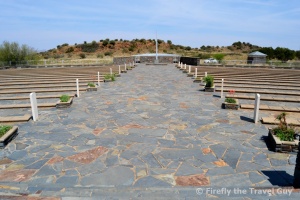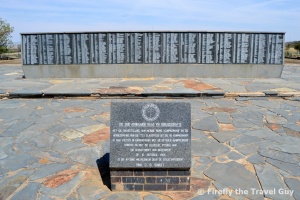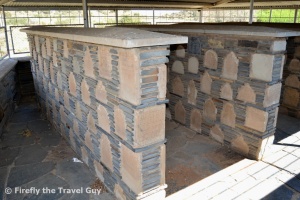Bethulie in the southern Free State is one of those places not many people pass through as it’s not really on any of the main thoroughfares going south (or north, depending how you look at it). On my last trip up to Johannesburg I deviated off the normal route to see what this town on the banks of the Orange River is all about. One of the things I found out was that Bethulie was the site of one of the most notorious concentration camps of the Anglo Boer War of 1899 to 1902. I was shocked by the size of the Concentration Camp Cemetery Memorial and even more so when I saw all the names on the remembrance wall.
It turns out that even the English called the Bethulie camp “the hell camp” because of the shocking conditions Boer men, women and children were being held in. The ravages of disease, starvation and extreme temperatures, enhanced by the bad administration of the camp, meant that the camp saw a death toll of 1 737 prisoners among its population of about 5 000 over the 13 months it existed between April 1901 and the end of the war in May 1902. At one stage about 30 people a day was buried in the camp. Truly shocking and it literally had me speechless as I stood reading the info around the memorial.
The original camp and cemetery was located much closer to the river back in the days but all the graves were relocated to this position when the Gariep Dam (called the Hendrik Verwoerd Dam back then) was constructed in the 1960’s.
At the top end of the cemetery is an enclosed area containing all the original hand-carved sandstone headstones which were removed from the old cemetery. They’ve all been set into three walls and having a closer look at the information on them you suddenly realise how many children were among those who had dies in the camp. Unfortunately the gate was locked tight so I couldn’t get a closer look at all of them,
I drove away deeply touched. The Anglo Boer War was such a significant event in the history of South Africa and yet so many of us never get to visit sites like this because it’s often off the beaten track. So next time you’re on the main drag down to the beach fro your summer holidays, why not set a day aside and take some of the back roads. You will come away the better for it.



I agree. Thank you for posting this. There is so much to read on the Boer War.Try “Emily Hobhouse -beloved traitor” by Elisabeth Brits. You won't put it down.
This comment has been removed by a blog administrator.
Wow, this is fascinating. I was in Bethulie for one night last year – I stayed in the amazing Royal Hotel (really worth a visit) – but didn't even know about the concentration camp cemetery. What an awful story.
We were there about 2008 and took a number of photos and I was happy to see some people were still trying to save our history. We stayed in Philippolis and visited and took some photos of some family graves there as well. Like Jonker, we were also touched by the sad situation but what I find more upsetting is the loss of patriotism in SA and the serious decay of our monuments, graveyards and the breakdown of the dignity of our ancestors……
We always stay over on a farm close to Bethulie on our way to PE – we love the town and all it holds.
Next time you visit Bethulie I invite you to stay with us at Ou Vellies Sleap-Inn or De Oude Schuur Campsite and we will throw in a royal tour of Bethulie's historical sites for you. A word of advice though, you will need a full day i.o.w. sleep over for two nights.
My mother was interned in Bethulie camp. Years ago, I interviewed her, the memories even more poignant today. I tell her story on my website:http://erroluys.com/boergirl.html
From BULALA: At a concentration camp, near the hamlet of Bethulie, Boer women interned there watched in despair as the burials oftheir children inexorably rose to almost 30 per day. Yet they heldfast to the promise of God in Matthew 10, verses 26-31:“Fear them not therefore: for there is nothing covered, thatshall not be revealed; and hid, that shall not be known.What I tell you in darkness, that speak ye in light: andwhat ye hear in the ear, that preach ye upon the housetops.And fear not them which kill the body, but are notable to kill the soul: but rather fear him which is able todestroy both body and soul in hell. Are not two sparrowssold for a farthing? And one of them will not fall on theground without your Father (knowing). But the very hairsof your head are all numbered. Fear ye not therefore, yeare of more value than many sparrows.”[Sometime after the end of the war, the surviving women ofthat camp (in which 1,800 civilians, mainly children, had perished)approached the widow of former-President Steyn ofthe Orange Free State, and requested her influence in ensuringthat the smallest coin minted in the country would bear theimpression of two mossies (“sparrows”). This was duly carriedout, and the tradition maintained until a new, black governmentcame into power over 90 years after that devastating war,whereupon that minting was discontinued.]
BRITAIN’S GREATEST RACIST “There is only a means, the resistance of the Boers to break; namely the toughest oppression. In other words, we need to kill the parents, so that the children have respect for us.” ~ Winston Churchill, Journalist, Morning Post. NOTE: Boer concentration camp deaths 22,074 of whom 22,074 were children under 16 years of age.
“NOTE: Boer concentration camp deaths 22,074 of whom 22,074 were children under 16 years of age.”As a copywriter I expect you have this fact right.
I visited this concentration camp many years ago. It was summertime and the temperature was in the late 30's but I remember being cold as we walked through there.